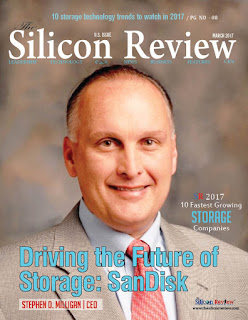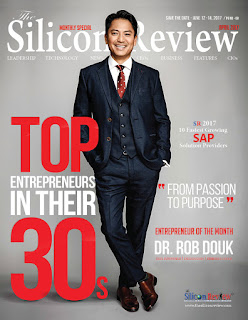The Silicon Review is the world's most trusted online and print community for business and tech professionals along with leading CXOs. With a key focus on IT trends, entrepreneurs, expert talks, we have US and Asia magazines for global reach. Subscribe to The Silicon Review magazine.
Saturday, 13 May 2017
Monday, 8 May 2017
Common Enterprise Storage mistakes and how to avoid them
Some mistakes are understandable, painless, and easy to correct. But others can be harmful enough to put your company on the path to failure – especially if left unaddressed. Here are the examples of common storage mistakes and how you can avoid them.
Undervaluing the role visibility plays in today’s digital environment
- Dynamic visibility tools combined with a Fiber Channel-based storage fabric can give you the ability to rapidly troubleshoot current or looming problem areas.
- Embracing an open, programmable, software-based architecture also provides the flexibility to quickly integrate network visibility tools without limiting the ability to scale your infrastructure. With greater visibility, you can harness network data to improve the customer experience, reduce network outages, enhance security, and create new revenue streams.
Failing to recognize the need for scalability and seamless integration
- Many companies are rapidly deploying new flash apps – often in “side deployments” – as well as hyper-converged solutions (HCI) from emerging providers. These solutions perform great in small environments with minimal IT staff.
- However, when these solutions are deployed in a real data center, scalability and protection will ultimately surface as primary challenges. While it’s easy to get hung up on the latest technology, you must be able to understand application capabilities and where these new tools fit – or don’t.
- While perceived ease of use and low IT resource needs are often the drivers for new technology, significant problems creep up when it comes to scaling, and more importantly when it comes time to integrate data stored within HCI environments.
- Bottom line: These types of solutions are not integrated into most storage networks today. And they do not have the other tools, like backup or DR apps, that are critical for the important data.
Ignoring the need for timely network upgrades
- Storage and server refreshes are not optional in today’s ever-evolving business environment. A new network is needed to keep up with the rate of change at both the AFA/NVMe end and the compute-density end.
- The requirement for 24/7 flawless performance is a new reality, with increasing workloads translating into the need to seamlessly maintain the infrastructure that runs at optimal levels.
- When you’re constantly focused on adding the next solution, it’s easy to lose sight of the foundation’s health. In these situations, the network can quickly become the weak link, diminishing the potential successes of any other solution added to the mix.
- Without undergoing a true rip-and-replace network rebuild, embracing a software-defined environment empowers faster application deployment while setting the stage for continued movement toward a truly agile architecture.
Not having a document retention schedule
- Keeping excess records is always a problem. If documents are sitting around after their usable life it can create a treasure trove of information that should have been destroyed but instead is now a large liability.
- A retention schedule will help your business keep records that are required by law or best practice while helping get rid of documents that are pasts their useful life and are now a liability.
- Storing important records on site within the walls of your business is a risky proposition. Most businesses are not built with the security that is necessary to protect sensitive information from criminal behavior.
- Off-site document storage facilities provide the security necessary to protect your documents while also providing the necessary access to your documents.Assuming your documents are backed up regularly Document management solutions seek to provide insurance against the fact that your paper documents are easily destroyed.
- Many companies get in the rut of thinking that their documents are automatically backed up by their document management provider without verifying that the backup is actually occurring on a regular basis.
- If anything were to ever happen and the backup was not actually occurring when it was supposed to, valuable data will be lost. Check out some tips for ensuring your backup records remain safe.
Using external storage devices
- With computer memory capacity getting larger and larger, external storage devices have become more and more popular for backing up data. The problem with backing up data on external storage devices like USB drives and external hard drives is that they can easily be stolen or lost.
- Using a cloud document management system will allow the storage necessary but still, allow you access like it is on an external storage device.
Monday, 1 May 2017
Sunday, 23 April 2017
Friday, 21 April 2017
Sunday, 16 April 2017
7 Latest Innovations in Robotics
Here are some of the latest robotics innovations and why there need to be skilled Mechatronics engineering technologists to help repair and maintain all of these great new robots.
Google's worker robots:
- Google is planning to produce worker robots with personalities. Engineers will enable the machines to download personalities from a cloud-based system.
- The robots have the capacity to store and display multiple personalities when interacting with humans.
- with specific idiosyncrasies for each user—rather like a family computer having different accounts for each family member.
Multi-tasking Robots:
- Momentum Machines have developed a multi-tasking bot particularly suited for “light assembly tasks and automated workbench scenarios” in a variety of industries.
- It is capable of preparing a gourmet hamburger in as little as 10 seconds. If all goes well, the robot could eventually be used in fast food restaurants.
UR3 arm:
- An automated device created by Universal Robots are known as UR3 can build its own replacement parts on the fly.
- The cute and nimble robot can handle a variety of tasks, such as gluing, painting, soldering, and grasping.
- The new table-top robot can also be used in a separate work station mounted on the table, picking, assembling and placing parts in optimized production flows.
Saul Robot:
- The Saul Robot is designed to help fight deadly diseases like the Ebola virus.
- Developed by Xenex, Saul eradicates traces of Ebola using powerful pulses of highly energetic ultraviolet rays. It breaks down and weakens cell walls of the virus.
- After patient and operation rooms are cleaned, the robot uses pulses of high-intensity, high-energy ultraviolet rays 25,000 times brighter than fluorescent lights to split open bacterial cell walls and kill dangerous pathogens commonly found in hospitals.
Asus Zenbo:
- Asus Zenbo is a low-cost robot capable of rolling around autonomously and understands verbal commands.
- Asus developed the device to help individuals remember daily tasks, such as exercise and medication schedules as well as doctor's appointments.
- Zenbo can also monitor the surroundings to detect any emergencies. It is capable of connecting to smart-home components like security cameras, lights, and door locks.
Paro:
- Paro is a therapeutic robot developed by AIST, a leading Japanese Industrial Automation pioneer.allows the documented benefits of animal therapy to be administered to patients in environments such as hospitals and extended care facilities.
- It has been proven effective when it comes motivating and assisting patients to relax.The psychological effects are drawn from the documented benefits of animal therapy.
- It comes with five different sensors, including posture, light, tactile, audition, and temperature sensors.
Pepper:
- Pepper is a talking humanoid robot that adapts its attitude based on how it perceives the mood of humans around it.The device detects emotional states like sadness, surprise, joy, and anger. It responds in a natural and appropriate fashion.
- Pepper uses multi-directional microphones to detect sounds.At the heart of Pepper is a remarkable technology that analyses what you say, your tone of voice and nonverbal communication cues like the tilt of your head or posture.
- From these, Pepper can instantly recognize the emotional context of the conversation and adjust accordingly. The result is human communication with the real emotional connection.
- For vision, Pepper employs a combination of 2HD and 3D cameras to recognize the shape of objects.
Friday, 14 April 2017
10 Fastest Growing Storage Companies 2017
The silicon review releasing the new magazine in Storage Services Providers... Find the success stories of Smart Leaders in Storage Industry 10 Fastest Growing Storage Companies 2017
Subscribe to:
Comments (Atom)





